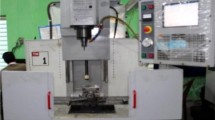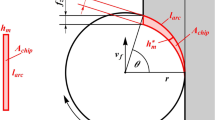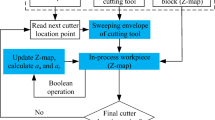Abstract
High-speed machining centers are used for end-milling operations of a variety of parts, dies, and molds needed in power and transport industries. Different approaches are used for rough and finish end-milling, since desired productivity and quality are important in the respective cases. In the present work, a feed rate adaption control system is proposed by integrating different requirements of high-speed end-milling. Hardened EN 24 steel which is being widely used in the production of dies, molds, and other parts is taken as a candidate work material for implementation of the proposed control system. Based on extensive experimentation, investigations have been carried out on high-speed rough and finish end-milling operations, and the details are reported by the authors (Saikumar and Shunmugam, Int J Adv Manuf Technol, under review). In this paper, relevant response surface and artificial neural network models have been used, and suitable reference parameters are obtained for the proposed control system. In the case of rough end-milling, material removal volume is taken as the objective, and the reference values for cutting force and cutting time are used. Only a reference cutting force is used for finish end-milling in which surface roughness is considered as the objective. Implementation details of the proposed PC-based control system are presented. The results obtained for a newly devised H–A–S–H test (short run) along with those for long-run tests are presented and discussed.
Similar content being viewed by others
References
Schmitz T, Davies M, Dutterer B, Ziegert J (2001) The application of high-speed CNC machining to prototype production. Int J Mach Tool Manu 41(8):1209–1228
Schulz H, Hock ST (1995) High-speed milling of dies and moulds—cutting conditions and technology. Ann CIRP 44(1):35–38
Elbestawi MA, Chen L, Becze CE, El-Wardany TI (1997) High speed milling of dies and molds in their hardened state. Ann CIRP 46(1):57–62
Urbanski JP, Koshy P, Dewes RC, Aspinwall DK (2000) High speed machining of moulds and dies for net shape manufacture. Mater Des 21:395–402
Dewes RC, Aspinwall DK (1997) A review of ultra high speed milling of hardened steels. J Mat Process Technol 69:1–17
Werthiem R (2002) Future direction for R&D in manufacturing engineering in Ireland and UK. CIRP Workshop, Dublin
Armarego EJA, Deshpande NP (1989) Computerized predictive cutting models of forces in end-milling including eccentricity effects. Ann CIRP 38(1):45–49
Yucesan G, Xie Q, Bayoumi AE (1993) Determination of process parameters through a mechanistic force model of milling operations. Int J Mach Tool Manu 33:627–641
Zheng L, Chiou YS, Liang SY (1996) Three dimensional cutting force analysis in end-milling. Int J Mech Sci 38(3):259–269
Fuh KH, Hwang RM (1997) A predicted milling force model for high-speed for high-speed end milling operation. Int J Mach Tool Manu 37:969–979
Kovacic M, Balic J, Brezocnik M (2004) Evolutionary approach for cutting forces prediction in milling. J Mat Process Technol 155–156(1):1647–1652
Ozcelik B, Bayramoglu M (2006) The statistical modeling of surface roughness in high-speed flat end milling. Int J Mach Tools & Manuf 46(12–13):1395–1402
Zain AM, Haron H, Sharif S (2010) Prediction of surface roughness in the end milling machining using Artificial Neural Network. Expert Systems with Applications 37(2):1755–1768
Prakasvudhisarn C, Kunnapapdeelert S, Yenradee P (2009) Optimal cutting condition determination for desired surface roughness in end milling. Int J Adv Manuf Technol 41(5–6):440–451
Routara BC, Bandyopadhyay A, Sahoo P (2009) Roughness modeling and optimization in CNC end milling using response surface method: effect of workpiece material variation. Int J Adv Manuf Technol 40(11–12):1166–1180
Saikumar S, Shunmugam MS (2006) Parameter selection based on surface finish in high-speed end-milling using differential evolution. Mat and Manuf Process 21(4):341–347
Saikumar S, Shunmugam MS (2010) Parameter selection in high speed finish end-milling of hardened En24 steel. In: Proceedings of the 3rd International and 24th AIMTDR Conference, Vishakhapatnam, India, Dec 2010, pp 1193–1198.
Dimla DE Jr, Lister PM, Leighton NJ (1997) Neural network solutions to the tool condition monitoring problem in metal cutting—a critical review of methods. Int J Mach Tool Manu 37(9):1219–1241
Dong J, Subrahmanyam KVR, Wong YS, Hong GS, Mohanty AR (2006) Bayesian-inference-based neural networks for tool wear estimation. Int J Adv Manuf Technol 30:797–807
Palanisamy P, Rajendran I, Shanmugasundaram S (2008) Prediction of tool wear using regression and ANN models in end-milling operation. Int J Adv Manuf Technol 37(1–2):29–41
Torabi AJ, Er MJ, Xiang L, Lim BS, Lianyin Z, Phua SJ, Junhong Z, Lin S, Sheng H, Tijo JTT (2009) A survey on artificial intelligence technologies in modeling of high speed end-milling processes. In: Proceedings of IEEE/ASME International Conference on Advanced Intelligent Mechatronics, AIM, Singapore, 2009, pp 320–325
Jawahir IS, Balaji AK, Rouch KE, Baker JR (2003) Towards integration of hybrid models for optimized machining performance in intelligent manufacturing systems. J Mat Process Technol 139(1–3):488–498
Haber RE, Jimenez JE, Peres CR, Alique JR (2004) An investigation of tool-wear monitoring in a high speed machining process. Sensors and Actuators 116:539–545
Li X, Li HX, Guan XP, Du R (2004) Fuzzy estimation of feed-cutting force from current measurement—a case study on intelligent tool wear condition monitoring. IEEE Trans Syst Man Cybern C Appl Rev 34(4):506–512
Liang SY, Hecker RL, Landers RG (2004) Machining process monitoring and control: the state-of-the-art. J Manuf Sci E-T ASME 126(2):297–310
Rehorn G, Jiang J, Orban PE (2005) State-of-the-art methods and results in tool condition monitoring: a review. Int J Adv Manuf Technol 26(7–8):693–710
Huang SN, Ta KK, Wong YS, de Silva CW, Goh HL, Tan WW (2007) Tool wear detection and fault diagnosis based on cutting force monitoring. Int J Mach Tool Manu 47:444–451
Lee KJ, Lee TM, Yang MY (2007) Tool wear monitoring system for CNC end milling using a hybrid approach to cutting force regulation. Int J Adv Manuf Technol 32:8–17
Li X, Zeng H, Zhou JH, Huang S, Thoe TB, Shaw KC, Lim BS (2007) Multi-modal sensing and correlation modeling for condition-based monitoring in milling machine. SIMTech Technical Reports 8(1):50–56
Landers RG, Ulsoy AG, Ma YH (2004) A comparison of model-based machining force control approaches. Int J Mach Tool Manu 44:733–748
Jee S, Koren Y (2004) Adaptive fuzzy logic controller for feed drives of a CNC machine tool. Mechatronics 14:299–326
Saikumar S, Shunmugam MS (2004) Implementation of a control scheme for CNC milling in aerospace manufacturing. In: Proceedings of CAMMT, IIT Madras, 2004, pp 121–122.
Zuperl U, Cus F, Kicker E (2006) Intelligent adaptive cutting force control in end-milling. Tehnički Vjesnik 13(1,2):15–22
Chen ZC, Miao Z (2006) An intelligent approach to non-constant feed rate determination for high-performance 2D CNC milling. Int J Manuf Tech Manag 9:219–236
Yang LD, Chen JC, Chow HM, Lin CT (2006) Fuzzy-nets-based in-process surface roughness adaptive control system in end-milling operations. Int J Adv Manuf Technol 28:236–248
Zhang JZ, Chen JC (2007) The development of an in-process surface roughness adaptive control system in end milling operations. Int J Adv Manuf Technol 31:877–887
Abellan JV, Romero F, Siller HR, Estruch A, Vila C (2008) Adaptive control optimization of cutting parameters for high quality machining operations based on neural networks and search algorithms. In: Arámburo J, Ramírez Treviño A (eds) Advances in robotics, automation and control. I-Tech Education and Publishing, Austria, pp 472–491
Xu C, Shin YC (2008) An adaptive fuzzy controller for constant cutting force in end-milling processes. J Manuf Sci E-T ASME 130(3):1–9
Vallejo A, Menendez RM, Siller HE (2009) Intelligent control system for HSM. JAMRIS 3(3):54–63
Montgomery DC (1976) Design and analysis of experiments. Willey, New York
Storn R, Price K (1997) Differential evolution—a simple and efficient heuristic for global optimization over continuous spaces. J Global Optim 11:341–359
MacKay DJC (1992) A practical Bayesian framework for back-propagation networks. Neural Comput 4:448–472
Math Works Incorporation (2005) Matlab user manual, version 7.1, R14. The Math Works Incorporation, Natick
Author information
Authors and Affiliations
Corresponding author
Rights and permissions
About this article
Cite this article
Saikumar, S., Shunmugam, M.S. Development of a feed rate adaption control system for high-speed rough and finish end-milling of hardened EN24 steel. Int J Adv Manuf Technol 59, 869–884 (2012). https://doi.org/10.1007/s00170-011-3561-6
Received:
Accepted:
Published:
Issue Date:
DOI: https://doi.org/10.1007/s00170-011-3561-6




